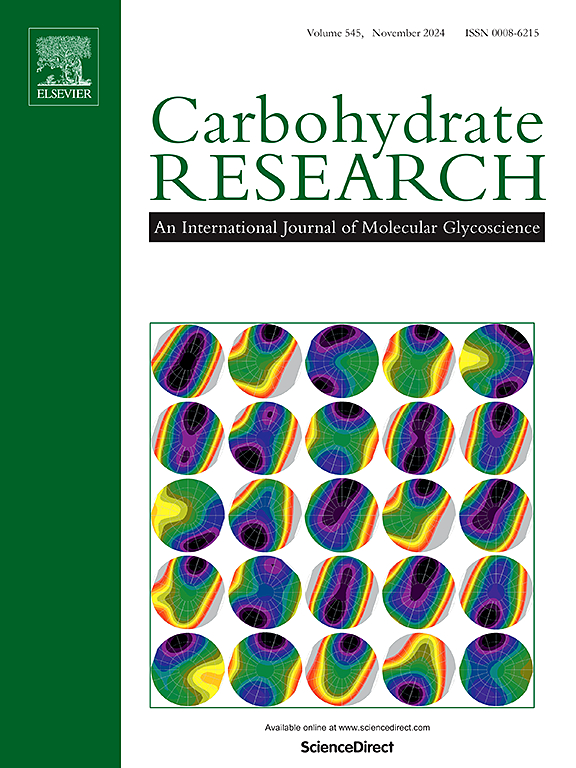Silver trifluoromethanesulfonate as a new efficient catalyst for glycosylation reactions using 2-alkoxy-glyco-[2,1-d]-2-oxazoline glycosyl donors, contributing to the suppression of side reactions of intermolecular aglycon transfer and polymerization of oxazoline derivatives of sugars
IF 2.4
3区 化学
Q3 BIOCHEMISTRY & MOLECULAR BIOLOGY
引用次数: 0
Abstract
The use of silver trifluoromethanesulfonate as a catalyst for glycoside synthesis using 2-(2,2,2-trichloroethoxy)-2-oxazoline glycosyl donors with d-gluco and d-galacto configuration has been studied. Silver trifluoromethanesulfonate allows the glycosylation reaction to be carried out under very mild conditions in a neutral medium, similar to the sym-collidinium trifluoromethanesulfonate previously used for this purpose. However, compared to sym-collidinium trifluoromethanesulfonate, silver trifluoromethanesulfonate provides better yields of target products and helps to suppress unwanted side reactions such as intermolecular aglycon transfer and polymerization of oxazoline derivatives of sugars. It has been found that the best results of oligosaccharide synthesis are obtained with an equimolar ratio between the glycosyl donor and the catalyst.

三氟甲烷磺酸银作为一种新的高效催化剂,用于2-烷氧基糖基-[2,1-d]-2-恶唑啉糖基供体的糖基化反应,有助于抑制糖基转移和恶唑啉糖基衍生物聚合的副反应
研究了以三氟甲烷磺酸银为催化剂,以2-(2,2,2-三氯乙氧基)-2-恶唑啉糖基为供体,采用d-葡萄糖和d-半乳糖构型合成糖苷。三氟甲烷磺酸银允许糖基化反应在非常温和的条件下在中性介质中进行,类似于以前用于这一目的的三氟甲烷磺酸钠对称碰撞体。然而,与三氟甲烷磺酸钠相比较,三氟甲烷磺酸银提供了更好的目标产物收率,并有助于抑制不良副反应,如糖的恶唑啉衍生物的分子间糖基转移和聚合。研究发现,当糖基供体与催化剂的摩尔比为等摩尔时,低聚糖的合成效果最好。
本文章由计算机程序翻译,如有差异,请以英文原文为准。
求助全文
约1分钟内获得全文
求助全文
来源期刊

Carbohydrate Research
化学-生化与分子生物学
CiteScore
5.00
自引率
3.20%
发文量
183
审稿时长
3.6 weeks
期刊介绍:
Carbohydrate Research publishes reports of original research in the following areas of carbohydrate science: action of enzymes, analytical chemistry, biochemistry (biosynthesis, degradation, structural and functional biochemistry, conformation, molecular recognition, enzyme mechanisms, carbohydrate-processing enzymes, including glycosidases and glycosyltransferases), chemical synthesis, isolation of natural products, physicochemical studies, reactions and their mechanisms, the study of structures and stereochemistry, and technological aspects.
Papers on polysaccharides should have a "molecular" component; that is a paper on new or modified polysaccharides should include structural information and characterization in addition to the usual studies of rheological properties and the like. A paper on a new, naturally occurring polysaccharide should include structural information, defining monosaccharide components and linkage sequence.
Papers devoted wholly or partly to X-ray crystallographic studies, or to computational aspects (molecular mechanics or molecular orbital calculations, simulations via molecular dynamics), will be considered if they meet certain criteria. For computational papers the requirements are that the methods used be specified in sufficient detail to permit replication of the results, and that the conclusions be shown to have relevance to experimental observations - the authors'' own data or data from the literature. Specific directions for the presentation of X-ray data are given below under Results and "discussion".
 求助内容:
求助内容: 应助结果提醒方式:
应助结果提醒方式:


